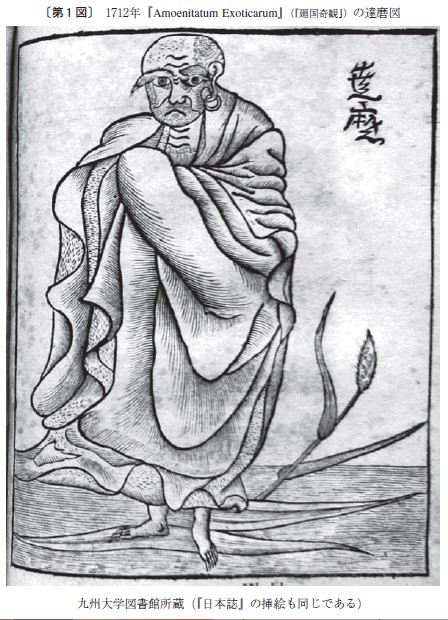There is an unique legend for the origin of tea (Camellia Sinensis), apart from the famous Chinese legend of discovery by Shennong[082]*, the mythical emperor in China.
*Shennong’s Story is introduced in many websites, especially China.org.cn is very easily understandable.
According to “the History of Japan” written by a German doctor “Engelbert Kaemfer”, tea plants arose from ripped eyelids of the originator of Zen Buddhism, “Bodhidharma”[083]. He continued an ascetic training for a long time without sleeping. However he fell asleep despite himself. His regret and rage against himself forced him to rip his eyelids out. Then, tea bushes arose in all the places his ripped eyelids fell. Bodhidharma tried to eat the leaves, resulting in the great concentration to the ascetic training due to the effect enhancing awareness. After this happening, tea became an essential item for the training among the Zen Buddhism monks. The effect of awareness enhancement is considered to be caused by caffeine.
 An image of Bodhidharma[083]
An image of Bodhidharma[083]
Buddhists in China have their own story similar to the legend of Bodhidharma. In this story, Siddhartha Gautama (Gautama Buddha, the originator of Buddhism) also fell asleep during his training to reach for the truth and enlightenment. When he awoke, he was so furious at himself that he ripped out his eyelashes and cast them to the wind. And then, in all the places they fell sprang forth a fragrant and flowering bushes of tea plants. Buddha recommended tea leaves to his followers with an explanation that tea leaves would keep us aware and awake, invigorated and focused, an intoxicant in the service of devotion[082].
Although there are many different stories about the relation between tea and Buddhism, almost all stories mentioned that tea leaves have various benefits for us.
Thanks to these stories, I could realize that a variety of teas” benefits was known and popular to people from the past time more than 2000 years ago. This fact would be one of the reason people like and are familiar to teas worldwide.
More than 300 years later from the era Bodhidharma lived, the monks of envoy to Tang Dynasty brought tea plants into Japan. This IS a stream of history. In the next opportunity, I’d like to write about the oldest record of tea ceremony in Japan.
— References —
[082] Sarah Rose (2009) “For All the Tea in China : how England stole the world’s favorite drink and changed history”, Penguin Group (USA) Inc., 375 Hudson Street, New York, New York 10014.
[083] Mizuki M. and Miyazaki K. (2014) “A legend for tea in “The history of Japan” written by Kaempfer : The relation between tea and Bodhidharma”, Departmental Bulletin Paper of Intercultural Studies in Seinan Gakuin University, 28:97-128.
